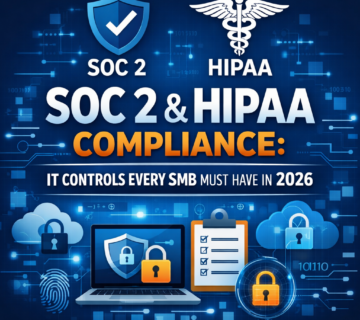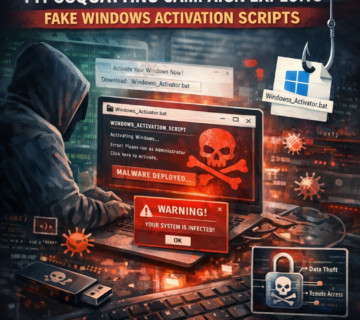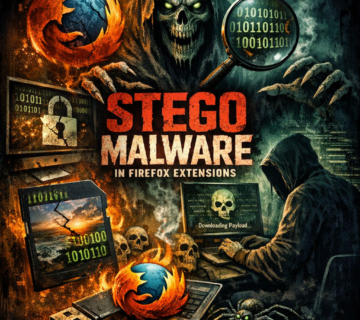Mamona Ransomware: The Stealthy New Threat Operating Without Internet Connection
Mamona Ransomware: The Stealthy New Threat Operating Without Internet Connection
👉 Listen to the Episode: https://technijian.com/podcast/mamona-ransomware-the-stealthy-offline-threat/Understanding the Latest Cybersecurity Challenge in 2025
Cybersecurity professionals are facing a new and sophisticated threat that challenges traditional defense mechanisms. The Mamona ransomware represents a significant evolution in malicious software design, operating entirely offline and employing advanced evasion techniques that make detection exceptionally difficult.
What Makes Mamona Ransomware Unique?
Offline Operation Strategy
Unlike conventional ransomware that requires internet connectivity to communicate with command-and-control servers, Mamona operates as a completely self-contained threat. This standalone approach eliminates the network traffic patterns that security systems typically monitor, creating a significant blind spot in traditional cybersecurity defenses.
Minimal Footprint Design
The ransomware’s streamlined architecture focuses on efficiency rather than complexity. By avoiding unnecessary features and maintaining a small file size, Mamona can execute quickly and quietly on target systems without triggering resource-based detection mechanisms.
Self-Destruction Mechanism
One of Mamona’s most concerning features is its ability to eliminate traces of its presence. After completing its malicious activities, the ransomware automatically removes itself from the infected system, making forensic analysis and incident response significantly more challenging.
How Mamona Ransomware Operates
Execution Process
The malware begins operation immediately upon execution on Windows systems. It requires no external dependencies or network connections, making it particularly dangerous in environments where internet access is restricted or monitored.
Evasion Techniques
Mamona employs a sophisticated three-second delay mechanism using a modified ping command: cmd.exe /C ping 127.0.0.7 -n 3 > Nul & Del /f /q. This technique serves multiple purposes:
- Detection Avoidance: The use of 127.0.0.7 instead of the common 127.0.0.1 helps bypass standard detection rules
- Timing Manipulation: The delay helps the malware blend in with normal system activity
- Self-Deletion: The command sequence includes instructions for automatic file removal
File Modification Process
Once active, Mamona performs its primary function by:
- Encrypting target files on the infected system
- Renaming affected files with the .HAes extension
- Creating a ransom note titled README.HAes.txt
- Leaving minimal forensic evidence
Detection Challenges and Solutions
Traditional Security Limitations
Standard antivirus solutions and network monitoring tools face significant challenges when dealing with Mamona because:
- No Network Activity: Traditional traffic analysis becomes ineffective
- Rapid Self-Deletion: Limited time window for detection
- Minimal System Impact: Low resource usage avoids performance-based alerts
Advanced Detection Strategies
Security researchers have developed specialized approaches to identify Mamona infections:
Behavioral Monitoring: Implementing systems that track file creation patterns, particularly the appearance of README.HAes.txt files and systematic file renaming activities.
System Event Analysis: Using tools like Sysmon to capture detailed system logs and identify suspicious command executions, especially those involving modified ping commands.
Real-Time File Integrity Monitoring: Deploying FIM systems that immediately flag unauthorized file modifications, particularly in high-risk directories like Downloads folders.
Prevention and Protection Strategies
Multi-Layered Security Approach
Protecting against Mamona requires a comprehensive security strategy that includes:
Endpoint Protection: Deploy advanced endpoint detection and response (EDR) solutions capable of behavioral analysis rather than relying solely on signature-based detection.
User Education: Implement regular training programs to help users identify and avoid potential ransomware delivery methods, including suspicious email attachments and downloads.
System Hardening: Configure systems to minimize attack surfaces, including disabling unnecessary services and implementing strict access controls.
Incident Response Planning
Organizations should prepare for potential Mamona infections by:
- Developing rapid response protocols for offline ransomware threats
- Creating backup strategies that account for local encryption attacks
- Establishing communication procedures for incidents involving self-deleting malware
Impact on Cybersecurity Industry
Evolution of Ransomware Tactics
Mamona represents a significant shift in ransomware development, moving away from complex command-and-control infrastructure toward simplified, self-contained attacks. This evolution has several implications:
Lower Entry Barriers: The simplified design makes it easier for less sophisticated attackers to deploy effective ransomware campaigns.
Increased Stealth: Offline operation significantly reduces the chances of detection during the attack phase.
Forensic Challenges: Self-deletion capabilities complicate post-incident analysis and attribution efforts.
Industry Response Requirements
The emergence of Mamona highlights the need for cybersecurity professionals to:
- Reevaluate existing detection mechanisms
- Develop new behavioral analysis capabilities
- Implement proactive monitoring strategies
- Enhance incident response procedures
Best Practices for Organizations
Immediate Actions
Organizations should take the following steps to protect against Mamona and similar threats:
- Update Security Policies: Revise cybersecurity policies to address offline ransomware threats
- Enhance Monitoring: Implement behavioral monitoring systems capable of detecting local file encryption activities
- Backup Strategy: Ensure robust backup systems that can quickly restore encrypted files
- Staff Training: Educate employees about the risks associated with executing unknown files
Long-Term Strategies
Technology Investment: Allocate resources for advanced endpoint protection solutions that can identify threats based on behavior rather than signatures.
Collaboration: Work with cybersecurity vendors to develop and implement detection rules specifically designed for self-contained ransomware threats.
Continuous Improvement: Regularly review and update security measures based on emerging threat intelligence and industry best practices.
How Technijian Can Help
Comprehensive Security Assessment
Professional cybersecurity experts at Technijian can provide thorough evaluations of your current security posture, identifying vulnerabilities that could be exploited by advanced threats like Mamona. This includes:
- Network security audits
- Endpoint protection reviews
- Policy compliance assessments
- Vulnerability scanning and penetration testing
Advanced Threat Detection Implementation
Experienced Technijian specialists can deploy and configure sophisticated monitoring systems designed to detect behavioral patterns associated with advanced ransomware threats:
- YARA rule implementation for pattern recognition
- Sysmon configuration for comprehensive system logging
- File Integrity Monitoring (FIM) system deployment
- Custom detection rule development
Incident Response and Recovery
When facing a potential Mamona infection, Technijian professionals provide:
- Rapid incident response coordination
- Forensic analysis of compromised systems
- Data recovery and system restoration services
- Post-incident security improvements
Ongoing Security Management
Technijian offers continuous security management including:
- 24/7 monitoring and threat detection
- Regular security updates and patch management
- Security awareness training programs
- Compliance reporting and documentation
Frequently Asked Questions
What is Mamona ransomware?
Mamona is a sophisticated ransomware strain that operates entirely offline, encrypting files locally without requiring internet connectivity. It uses advanced evasion techniques including self-deletion to avoid detection and complicate forensic analysis.
How does Mamona differ from traditional ransomware?
Unlike conventional ransomware that communicates with command-and-control servers, Mamona operates as a standalone executable file. It doesn’t require internet access, making it harder to detect using traditional network monitoring tools.
What files does Mamona target?
Mamona targets various file types on Windows systems, renaming encrypted files with the .HAes extension and leaving a ransom note titled README.HAes.txt in affected directories.
How can I protect my organization from Mamona?
Protection requires a multi-layered approach including advanced endpoint protection, behavioral monitoring systems, regular backups, user education, and incident response planning specifically designed for offline ransomware threats.
What should I do if I suspect a Mamona infection?
Immediately isolate affected systems, contact cybersecurity professionals, preserve any available evidence, and activate your incident response plan. Do not attempt to remove the ransomware without professional assistance.
Can traditional antivirus software detect Mamona?
Traditional signature-based antivirus solutions may struggle to detect Mamona due to its self-deletion capabilities and lack of network activity. Advanced behavioral analysis tools and endpoint detection systems are more effective.
How long does Mamona take to encrypt files?
The encryption process varies depending on the number and size of files, but Mamona’s streamlined design allows it to work quickly and efficiently before self-deleting within seconds of completion.
Is it possible to recover files encrypted by Mamona?
File recovery depends on several factors including backup availability, system snapshots, and the speed of incident response. Professional data recovery services may be able to help in some cases.
What industries are most at risk from Mamona?
All industries using Windows systems are potentially at risk, but organizations with limited cybersecurity resources, inadequate backup systems, or heavy reliance on local file storage face higher risk levels.
How often should I update my security measures against threats like Mamona?
Security measures should be continuously monitored and updated. Implement real-time threat intelligence feeds, conduct monthly security assessments, and review incident response procedures quarterly to stay protected against evolving threats.
About Technijian
Technijian is a premier managed IT services provider, committed to delivering innovative technology solutions that empower businesses across Southern California. Headquartered in Irvine, we offer robust IT support and comprehensive managed IT services tailored to meet the unique needs of organizations of all sizes. Our expertise spans key cities like Aliso Viejo, Anaheim, Brea, Buena Park, Costa Mesa, Cypress, Dana Point, Fountain Valley, Fullerton, Garden Grove, and many more. Our focus is on creating secure, scalable, and streamlined IT environments that drive operational success. As a trusted IT partner, we prioritize aligning technology with business objectives through personalized IT consulting services. Our extensive expertise covers IT infrastructure management, IT outsourcing, and proactive cybersecurity solutions. From managed IT services in Anaheim to dynamic IT support in Laguna Beach, Mission Viejo, and San Clemente, we work tirelessly to ensure our clients can focus on business growth while we manage their technology needs efficiently. At Technijian, we provide a suite of flexible IT solutions designed to enhance performance, protect sensitive data, and strengthen cybersecurity. Our services include cloud computing, network management, IT systems management, and disaster recovery planning. We extend our dedicated support across Orange, Rancho Santa Margarita, Santa Ana, and Westminster, ensuring businesses stay adaptable and future-ready in a rapidly evolving digital landscape. Our proactive approach to IT management also includes help desk support, cybersecurity services, and customized IT consulting for a wide range of industries. We proudly serve businesses in Laguna Hills, Newport Beach, Tustin, Huntington Beach, and Yorba Linda. Our expertise in IT infrastructure services, cloud solutions, and system management makes us the go-to technology partner for businesses seeking reliability and growth. Partnering with Technijian means gaining a strategic ally dedicated to optimizing your IT infrastructure. Experience the Technijian Advantage with our innovative IT support services, expert IT consulting, and reliable managed IT services in Irvine. We proudly serve clients across Irvine, Orange County, and the wider Southern California region, helping businesses stay secure, efficient, and competitive in today’s digital-first world.





